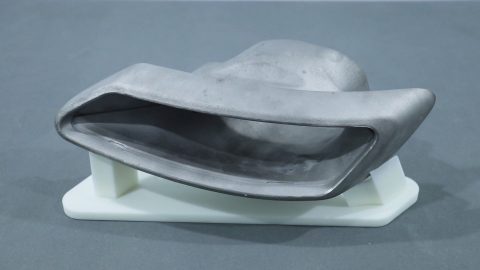
SHINING 3D has reduced to just a week to create a new exhaust that previously from design to production of a functional test unit could take up to three weeks
SHINING 3D has been working in close contact with automotive companies and motorsports teams for years to help them adopt additive manufacturing and increase productivity while reducing costs. In a recent case, SHINING 3D helped an automotive company design, produce and test a new exhaust pipe through a new phase of product development. The metal powder bed fusion (MPBF) technology from SHINING 3D, with the EP-M250 3D printer, and the high-precision OptimScan 5 blue-light 3D scanning and inspection technology were used during the process.
In traditional automotive manufacturing, it can take as long as 3 years to go from a new design to the final manufacturing of the first car from the factory. This latest case proves how additive manufacturing technologies can be extremely beneficial, not just to shorten the design and production cycle, but also for producing more complex and efficient parts. In recent years, several of the largest and best known automotive companies, including BMW, Audi and Volkswagen to name just a few, have set up additive manufacturing centers to integrate these new technologies into their manufacturing workflows.
From 3D printing to 3D inspection
In this application case, all manufacturing of the part was carried out with the EP-M250 metal 3D printer from SHINING 3D instead of costly, part-specific tooling. Doing away with tools significantly shortened the production time while also guaranteeing high quality and reliability of the part. After manually removing supports and sandblasting, the 3D printed exhaust pipe was ready for testing and adjusting.
The OptimScan-5M blue-light metrology 3D scanner was subsequently used to obtain the part’s 3D data, in a matter of just a few seconds, with accuracy up to 5µm. This level of precision fully met the requirements of industrial 3D inspection. In order to generate the analysis report, the engineers imported the 3D scan data and original CAD design model into Geomagic Control X. This intuitive report software tool allows the user to identify issues and make adjustments faster, thus offering better assistance to the decision-making process and improving efficiency.
Meeting demand for mass customization
In the end, the additive manufacturing and 3D inspection approach decreased the required time period to go from design to part installation to just one week, significantly reducing production time, risks and costs. But that’s only part of the story. Additional benefits of using innovative and finally accessible metal AM technologies include the creation of new, lightweight designs with more geometric freedom, thus also meeting the increasing demand for customization in the automotive industry.
There is no doubt that additive manufacturing will play an increasingly relevant role in the future of the automotive industry. SHINING 3D just launched a new metal 3D printer EP-M250 Pro at Formnext 2019, and the company intends to continue to support this evolution by developing technologies for direct printing, batch production of customized parts, and larger parts manufacturing in a wider range of applications.
Source: 3dprintingmedia